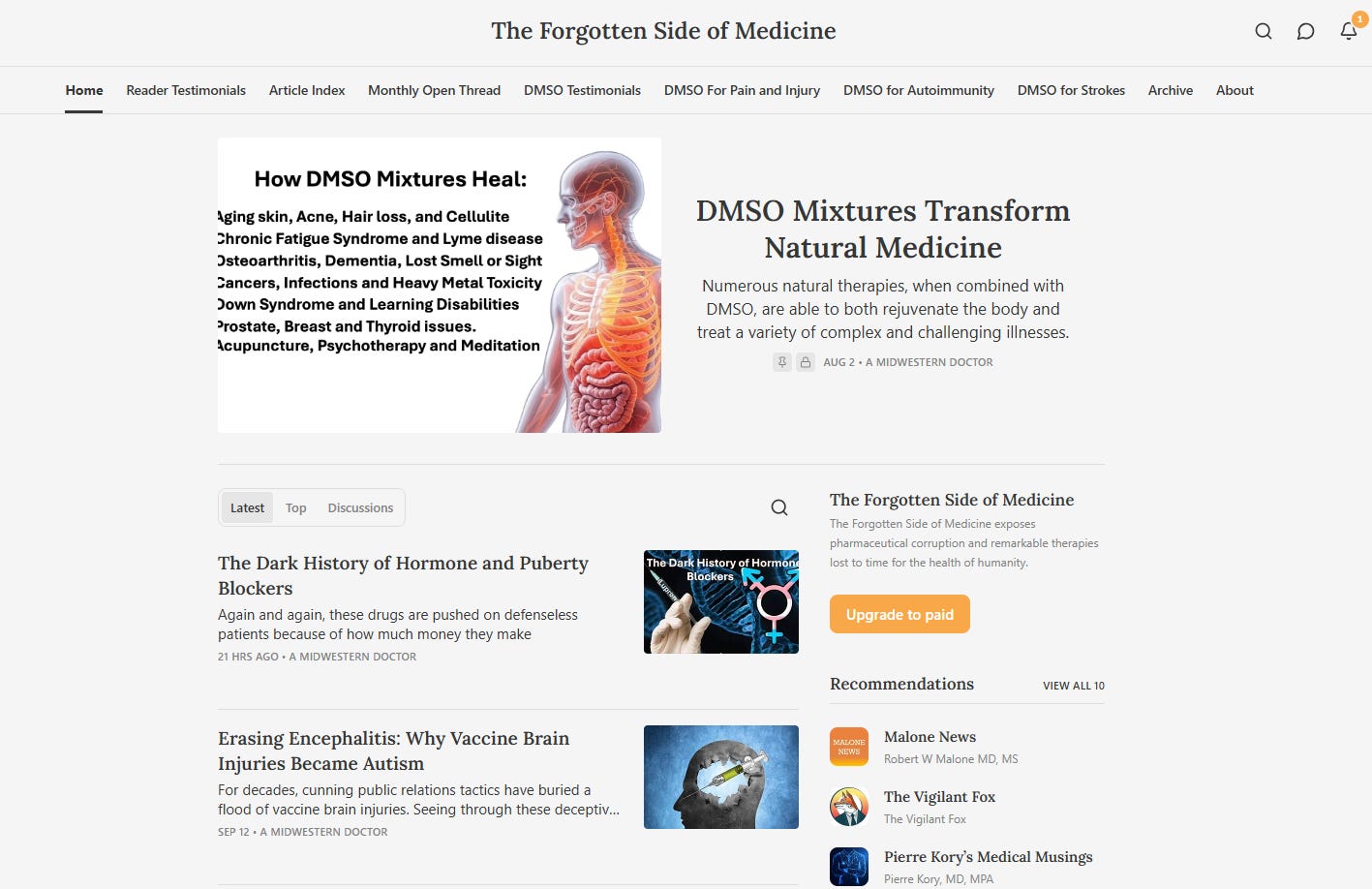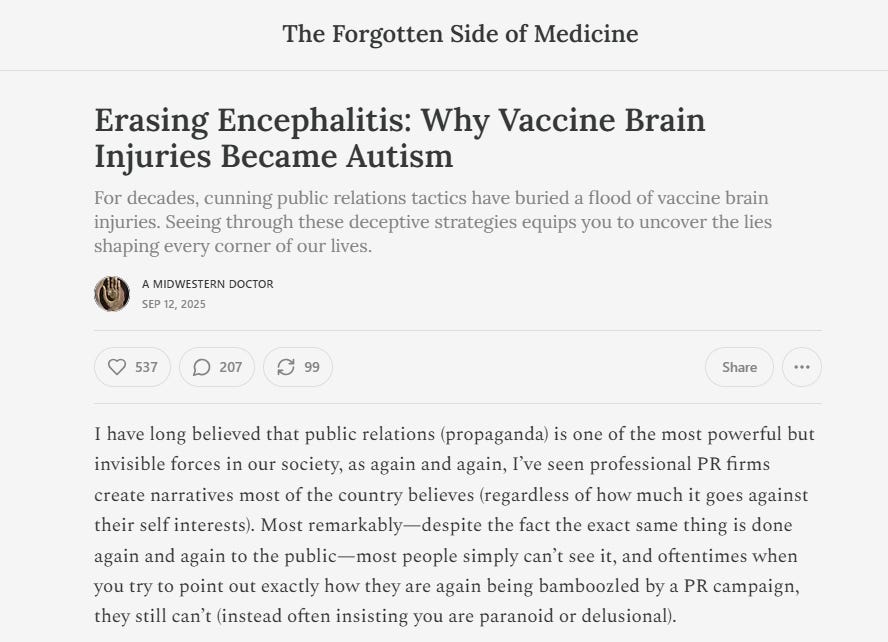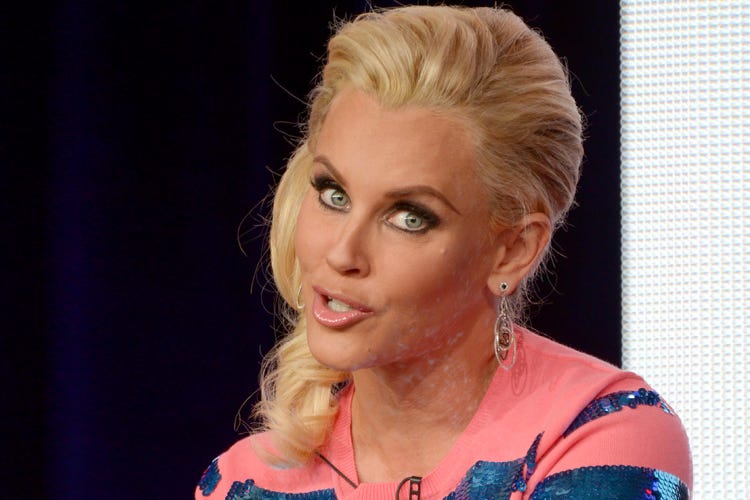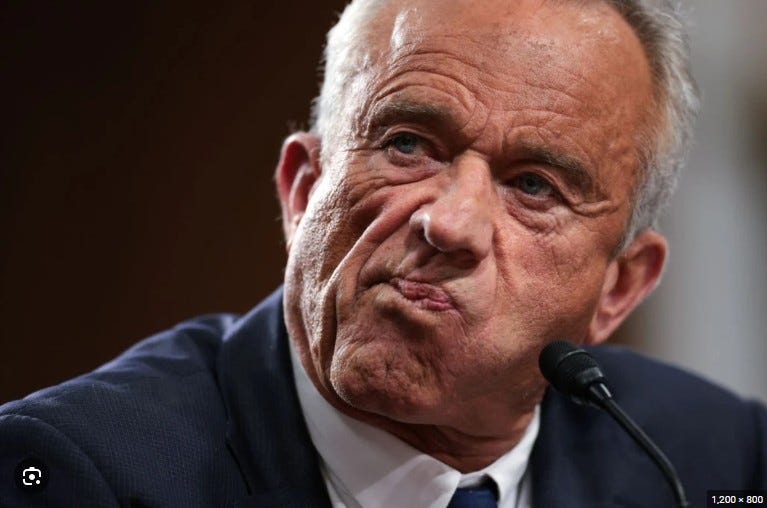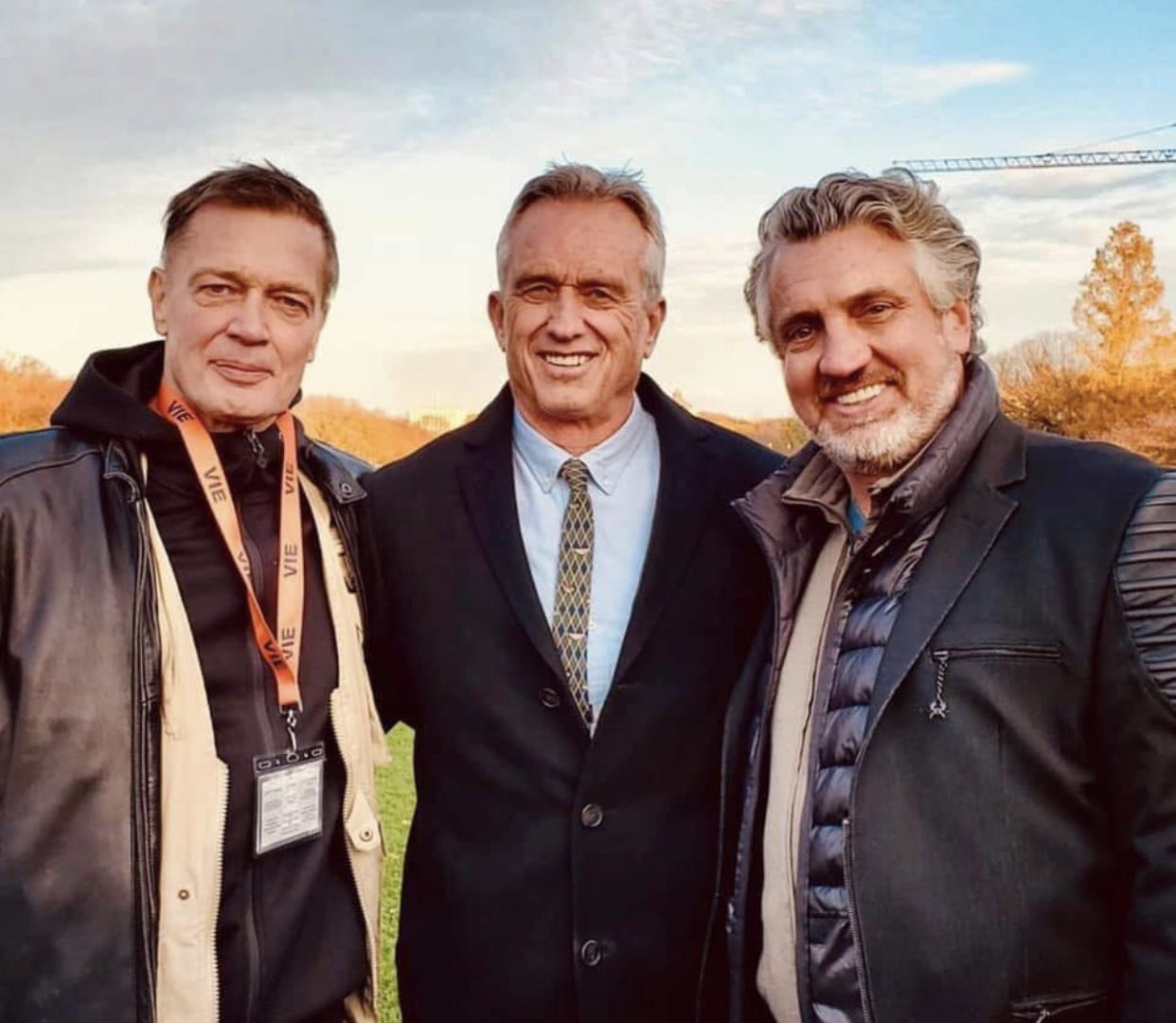The Phantom Physician: How America's Most Dangerous Medical Misinformation Empire Was Built by Ghosts
In the shadowy corners of the Internet, anonymous figures are making millions spreading deadly lies about vaccines while children pay the ultimate price.
By Josh Powell
Author’s Note: When I mentioned this article to a friend, she wondered with concern whether I might face legal repercussions from the so-called "Midwestern Doctor."
I practically cackled.
Sue me? This phantom practitioner would have to emerge from his or her carefully constructed anonymity —fully exposed, names attached, real identities blazing under the klieg lights of legal discovery. This entire cottage industry depends on the opposite: lurking behind pseudonyms while harvesting Substack subscriptions from the credulous masses hungry for medical misinformation served with a side of folksy authority.
If The Midwestern Doctor dragged me into court, I'd be performing a public service. The exposure would be fatal to his or her business model. This charlatan would sooner sprout wings and attempt a lunar expedition than risk having their identity scrutinized in open court. Without their shadowy mystique, they'd lose both their ego-stroking audience and their revenue stream.
There's something perverse about a culture that demands transparency from everyone except those peddling medical advice that could kill your children. In the gilded corridors of Silicon Valley's content economy, where authenticity is supposedly the ultimate currency, one of the most profitable empires has been built on the most elaborate lie of all: anonymity as authority.
Meet "A Midwestern Doctor"—though of course, you can't actually meet them, because they don't exist. Not in any verifiable sense. What does exist is a Substack newsletter called "The Forgotten Side of Medicine" that has amassed over 294,000 subscribers, not all of course paying monthly fees, to consume medical misinformation so sophisticated it makes The Protocols of the Elders of Zion look like amateur hour.
This digital charlatan has perfected the art of twenty-first-century snake oil salesmanship: take the deadliest medical conspiracy theory of our time—that vaccines cause autism—dress it up in enough scientific jargon to fool desperate parents, and hide behind an anonymous byline that provides complete immunity from professional consequences, legal liability, or basic human decency.
The poison they're peddling isn't new. The false claim that vaccines cause autism through brain inflammation called encephalitis is simply a repackaged version of fraudulent research that has been thoroughly debunked by every credible medical institution on the planet. But in our post-truth economy, truth is optional; plausible deniability and profit margins are not.
The Invisible Hand of Medical Mayhem
What makes "A Midwestern Doctor" particularly sinister isn't just the medical misinformation—it's the brazen cynicism of the business model. According to analysis by the Center for Countering Digital Hate (2022), Substack generates millions in revenue annually from anti-vaccine content, with top medical misinformation writers earning substantial monthly incomes from their dangerous theories. Our anonymous friend, with their subscriber base, is likely pulling in six figures annually for convincing parents that life-saving vaccines are actually brain-damaging poisons.
The encephalitis-autism connection this phantom promotes is medical fiction of the highest order. Genuine vaccine-induced encephalitis occurs in fewer than 1 in 1 million MMR vaccine doses (Stratton et al., 2013). Natural measles, by contrast, causes encephalitis in 1 in 1,000 cases—making the disease a thousand times more dangerous than the vaccine designed to prevent it. But why let facts interfere with a good revenue stream?
The scientific community has eviscerated these theories with the kind of thoroughness usually reserved for peer review at Nature. Home video analysis consistently shows autism symptoms appearing months before any vaccines are administered (Maestro et al., 2002). The structural brain changes characteristic of autism occur during fetal development, not after birth when vaccines are given (Courchesne et al., 2007). Every major epidemiological study involving millions of children has found no connection between vaccines and autism (Taylor et al., 2014).
But "A Midwestern Doctor" isn't interested in science—they're interested in what Rebecca Solnit might call the "profits of doom." In their shadowy digital empire, anonymity isn't just a convenience; it's the entire business model. No medical board can sanction someone who doesn't exist. No journalist can investigate credentials that are never claimed. No grieving parent can sue a phantom.
The Original Sin: A Very British Fraud
To understand how we arrived at this moment of digital medical nihilism, we must return to where this particular horror story began: not in some anonymous blogger's fever dreams, but in the corridors of one of London's most prestigious hospitals, where a real doctor with a real name committed very real fraud for very real money.
Andrew Wakefield was everything "A Midwestern Doctor" isn't: credentialed, accountable, and ultimately, prosecutable. In 1998, as a gastroenterologist at Royal Free Hospital, Wakefield published what would become the most destructive medical fraud of the modern era—a fabricated study claiming the MMR vaccine caused autism (Wakefield et al., 1998).
The fraud was so elaborate it shocked. Wakefield had been secretly paid £435,000 by lawyers planning to sue vaccine manufacturers (Deer, 2011). He systematically falsified medical records, conducted unethical procedures on children, and even paid kids at his son's birthday party £5 each for blood samples. The financial motive was staggering: he stood to earn up to $43 million annually from diagnostic kits for a syndrome he'd invented (Deer, 2011).
When investigative journalist Brian Deer exposed the fraud, The Lancet fully retracted the study, and Wakefield was stripped of his medical license (Godlee et al., 2011). But by then, the damage was done. The Danish cohort study that followed 657,461 children found no increased autism risk from MMR vaccination—if anything, vaccinated children had slightly lower autism rates (Hviid et al., 2019). Multiple investigations confirmed the data fabrication. Yet the lie had already begun its profitable journey around the world.
Unlike our anonymous Substack grifter, Wakefield faced consequences. Real consequences. Career-ending, reputation-destroying, exile-to-America consequences. Which is precisely why the next generation of medical misinformation merchants learned the most important lesson of all: never use your real name.
The Madonna of Maternal Misinformation
If Wakefield was the architect of the vaccine-autism lie, Jenny McCarthy became its patron saint—a distinctly American fusion of celebrity, sexuality, and pseudoscience that could only flourish in our tabloid-industrial complex.
McCarthy's transformation from Playboy centerfold to anti-vaccine crusader reads like a Black Mirror episode scripted by someone who'd overdosed on Us Weekly. When her son Evan was diagnosed with autism in 2005, she didn't seek solace in support groups or evidence-based treatments. Instead, she reached for the nearest camera and the most discredited medical theory she could find.
"Without a doubt, in my mind, I believe vaccinations triggered Evan's autism," she declared with the kind of absolute certainty usually reserved for religious zealots and reality TV contestants (McCarthy, 2007). Armed with nothing more than a Playboy pedigree and a mother's grief, she appointed herself a medical expert and took her message to the masses.
The result was what public health experts now call "The Jenny McCarthy Effect"—the demonstrable correlation between her media appearances and declining vaccination rates. When she appeared on The Oprah Winfrey Show in 2007, Google searches for "autism vaccines" spiked like a tech stock in a bubble market. Her book tours coincided with measurable increases in vaccine hesitancy across the United States, proving that in our celebrity-obsessed culture, a Playboy centerfold's medical opinions carried more weight than decades of peer-reviewed research.
But McCarthy's real genius wasn't in her medical theories—it was in her marketing. She promoted "treatments" that were as dangerous as they were profitable: chelation therapy that has actually killed children (Brown et al., 2006), hyperbaric oxygen chambers, electromagnetic treatments, and a whole carnival of expensive interventions with no scientific basis whatsoever.
The scientific rebuttals to McCarthy's claims are as comprehensive as they are ignored by her followers. Children encounter thousands more antigens daily from their environment than from all vaccines combined (Offit et al., 2002). The aluminum content in vaccines is less than what infants consume from breast milk. Natural measles infection kills 1-2 per 1,000 cases and causes permanent brain damage in others (Griffin, 2013)—making the disease McCarthy encouraged parents to risk exponentially more dangerous than the vaccines designed to prevent it.
Unlike our anonymous digital phantom, McCarthy eventually faced some consequences for her dangerous advocacy. She was awarded the James Randi Educational Foundation's "Pigasus Award" for "fooling the greatest number of people with the least amount of effort." But the real consequence was measured in smaller caskets and grieving families as preventable diseases returned to communities that had forgotten why we vaccinated against them in the first place.
The Kennedy Curse Goes Viral
Robert F. Kennedy Jr.'s journey from environmental lawyer to vaccine conspiracy theorist represents perhaps the most tragic waste of inherited credibility in American political history. Here was a man born with every advantage—the Kennedy name, Harvard education, legitimate legal career—who chose to squander it all on medical theories that wouldn't pass muster at a PTA meeting.
Kennedy's descent into vaccine misinformation began with his 2005 Rolling Stone article "Deadly Immunity," which alleged a government conspiracy to hide thimerosal dangers (Kennedy, 2005). The piece was so riddled with factual errors that Rolling Stone eventually removed it entirely, but Kennedy never acknowledged his mistakes. Instead, he doubled down with the kind of obstinate privilege that only generational wealth; a desire to rewrite his trouble youth; multiple marriages and failed political aspirations can provide.
The scientific response to Kennedy's thimerosal theories was swift and definitive. Thimerosal was removed from childhood vaccines by 2001, yet autism rates continued rising. Multiple studies, including one following children in Denmark where thimerosal was removed in 1992, found no association between thimerosal exposure and autism (Hviid et al., 2003). But Kennedy continued promoting debunked theories with the confidence of someone who'd never faced real consequences for being catastrophically wrong.
By July 2023, Kennedy had descended into complete medical nihilism, declaring on a podcast that "there's no vaccine that is safe and effective"—a statement so divorced from reality it would be comic if not for his current position as Secretary of Health and Human Services (Kennedy, 2023). Vaccines have prevented an estimated 154 million deaths over the past 50 years according to WHO data (WHO, 2024). The 2021 systematic review found serious adverse events occur in fewer than 1 in 100,000 doses for most vaccines (Xu et al., 2021).
Kennedy's rise to the nation's top health position represents the ultimate triumph of conspiracy thinking over scientific expertise. Private emails released by his own niece, Dr. Kerry Kennedy Meltzer, showed him spreading COVID-19 vaccine misinformation while she was treating dying patients in ICU units. The juxtaposition was perfectly American: a Kennedy spreading medical conspiracy theories while an actual doctor in the family tried to save lives.
The Producer's Gambit
Del Bigtree represents something uniquely sinister in our media landscape: the application of Hollywood production values to medical misinformation. A former television producer with no medical training, Bigtree has created what may be the most sophisticated anti-vaccine propaganda operation in existence.
Through his organization ICAN and web show "The Highwire," Bigtree has given vaccine conspiracy theories the kind of professional polish usually reserved for 60 Minutes exposés. His shows feature impressive graphics, dramatic pacing, and the kind of investigative journalism aesthetics that make conspiracy theories feel like breaking news.
But Bigtree's real innovation isn't in production values—it's in the systematic weaponization of scientific terminology. He regularly claims that vaccines have never been tested in placebo-controlled trials, a statement that sounds damning until you understand that every vaccine undergoes rigorous placebo-controlled trials before approval (Plotkin, 2013). After initial approval, subsequent vaccines are tested against existing vaccines rather than placebo because medical ethics prohibit exposing people to preventable diseases when effective interventions exist.
Bigtree's organization ICAN has generated millions in revenue while filing strategic Freedom of Information Act requests designed not to uncover genuine safety concerns but to create confusion and doubt. When government agencies can't immediately produce documents in exactly the format ICAN requests, Bigtree presents this as evidence of cover-ups rather than normal bureaucratic limitations.
The financial success of Bigtree's misinformation empire is staggering. ICAN's revenue jumped 60% in 2020 to $5.5 million, with Bigtree personally earning over $280,000 annually to spread dangerous health misinformation. During the COVID-19 pandemic, as real physicians risked their lives treating patients, Bigtree used the crisis to expand his audience and increase donations to his organization.
Unlike our anonymous Substack phantom, Bigtree operates in the open, using his real name and claiming expertise he doesn't possess. But like "A Midwestern Doctor," he's discovered that there's enormous money to be made in medical misinformation—as long as you're shameless enough to prioritize profits over children's lives.
The Ecosystem of Deception
What makes these figures particularly dangerous isn't just their individual influence but how their combined efforts have created a self-reinforcing ecosystem of medical misinformation that now includes anonymous digital profiteers who can monetize these deadly lies with complete impunity.
The playbook is always the same: cherry-pick data while ignoring overwhelming contradictory evidence, create false equivalencies between unfounded opinions and established scientific consensus, exploit parental fear by suggesting vaccines threaten children while downplaying real disease risks, and monetize the misinformation through books, speaking fees, and digital subscriptions.
The human cost has been measured in hospitalizations, disabilities, and deaths. The 2019 measles outbreak in the United States was directly linked to declining vaccination rates in communities influenced by anti-vaccine misinformation (Patel et al., 2019). In Europe, measles killed 72 people in 2018, almost all unvaccinated (WHO, 2019). Every one of these deaths was preventable.
The Digital Reckoning
Today, as measles outbreaks spread across communities with low vaccination rates, our cast of medical misinformation merchants continues their profitable work. Wakefield, though stripped of his medical license, still travels the world speaking to anti-vaccine groups. McCarthy has largely retreated from public anti-vaccine advocacy but has never recanted her dangerous statements. Kennedy now sits in the nation's top health position with the power to influence vaccine policy for an entire generation. Bigtree continues building his media empire, reaching new audiences with increasingly sophisticated propaganda.
But it's the anonymous figures like "A Midwestern Doctor" who may represent the greatest threat to public health. Operating with complete impunity behind digital pseudonyms, they can profit from recycling these same debunked theories to hundreds of thousands of subscribers while facing none of the professional, legal, or social consequences that legitimate medical professionals would face.
Their success reveals something deeply troubling about our information ecosystem: in an age when we supposedly value authenticity above all else, we've created economic incentives for the most sophisticated forms of deception. The most dangerous medical misinformation isn't coming from obviously crazy sources—it's coming from anonymous figures who've learned to weaponize credibility they never earned.
The stakes couldn't be higher. These digital phantoms aren't just spreading misinformation—they're eroding the foundation of evidence-based medicine itself. In a world where anonymous bloggers can earn six figures spreading medical conspiracy theories while pediatricians struggle to convince parents to protect their children, we've created a system that rewards the most dangerous forms of deception while punishing those who dedicate their lives to healing.
The vaccine-autism myth represents more than just a successful misinformation campaign—it's a preview of our post-truth future, where anonymous figures can profit from deadly lies while the rest of us pay the price in preventable suffering and death. Until we find ways to hold these digital phantoms accountable, children will continue to pay the ultimate price for adult fantasies about medical conspiracy theories.
In the end, "A Midwestern Doctor" and their anonymous ilk represent something uniquely American: the transformation of ignorance into influence, prejudice into profit, and conspiracy theories into cash. They've discovered that in our attention economy, you don't need credentials to claim authority—you just need subscribers. And as long as there are desperate parents willing to pay for certainty in an uncertain world, there will always be someone willing to sell them lies dressed up as medical expertise that can literally put the world at risk.
And if this is not bad enough, when a large health misinformation accounts share false information about vaccines, medications, or treatments, the reach can be devastating and unstoppable. With his or her 294,000 followers, if A Midwestern Doctor’s subscribers were share with 2 others who then these people were to share with 2 more, over 2 million people could be exposed to dangerous misinformation. This mathematical reality shows why combating health misinformation requires coordinated efforts from platforms, health authorities, and media literacy education.
I hoped you enjoyed this article and others from The Powell House Press. These pieces take time and research. The goal is to provide readers with real verifiable information and opinion articles that are thought out with conclusions based on facts. Your financial support is what keeps this going. If you can, would you consider becoming a paid subscriber?



